The Real Statement Piece? Natural Hair at the 2025 Met Gala
From History to Identity to Statement.
The Met Gala carpet always glitters, but this year, something deeper stole the spotlight: roots.
Not just in tailoring or theme, but in hair — coiled, braided, twisted, and free. With this year’s exhibition, “Superfine: Tailoring Black Style,” Black celebrities weren’t just showing up dressed, they were showing up defined. Defined by history, by pride, and by choices stitched not only into garments, but into hairlines, textures, and tradition.
The truth is…the sharpest interpretations of Black dandyism have never stopped at the seam. They’ve always extended to the scalp — to edges laid with care, to pomades and partings, to braids and coils crafted with precision. The polish, the ritual, the grooming…it’s all part of the look. So it made perfect sense that some of the night’s most meaningful moments weren’t found in lapels or brooches, but in hair that was sculpted, styled, and crowned with intention.
What does it mean to wear an afro on fashion’s biggest stage? Where do braids come from, and what have they carried — literally and symbolically — across generations? What do locs represent beyond style? Black hair holds memory. It’s a language, an archive, a legacy. And this year, it spoke volumes on the Met steps.
If you’re enjoying our articles, send a matcha our way. 🍵 It’s my favorite drink and now a sweet way to support Fashion Talk — a free platform made with love and intention. To those who already have: your taste is impeccable.
— Amarissa ♡
In many African civilizations, hair functioned as a social signifier: detailing everything from marital status to tribal affiliation, from mourning to spiritual connection. Journalist Lori Tharps once noted that “just about everything about a person's identity could be learned by looking at their hair.”
That legacy didn’t disappear with time, it evolved. And perhaps no style carries that weight quite like the afro. Bold, beautiful, and deeply political, it remains one of the most visible declarations of pride in Black identity.
The Legacy of the Afro

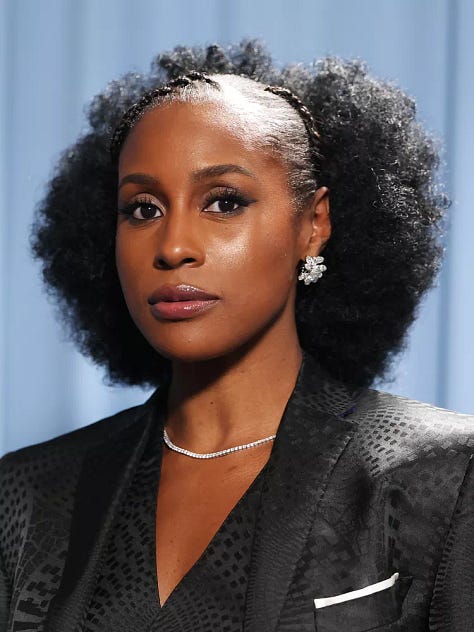

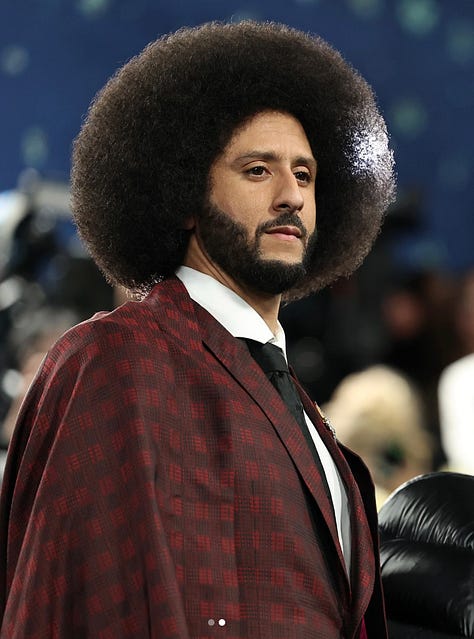
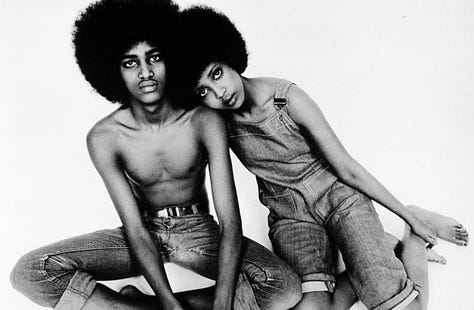
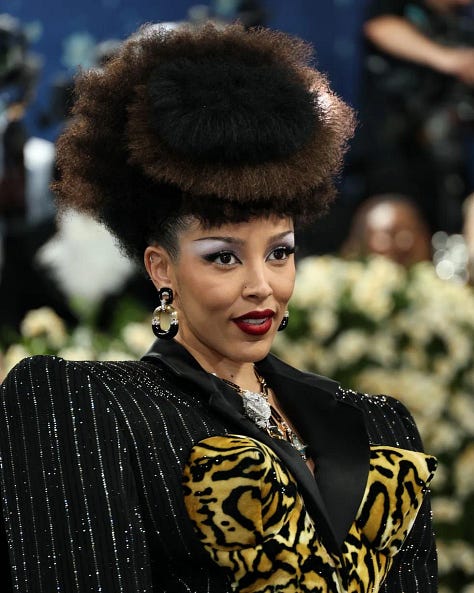


In the 1960s, the afro wasn’t just growing, it was rising. High. Defiant. Loud in its silence. As the Civil Rights Movement gained momentum, this crown of coiled glory became a symbol. Of pride. Of protest. Of power. It was a full-body rejection of Eurocentric beauty standards and a full-hearted embrace of Blackness in its most natural, unapologetic form.
Alongside it came the return of the Afro pick, especially the iconic “fist comb” shaped like the Black Power salute. That symbol, often misunderstood or misattributed, was born from a need to assert dignity in the face of systemic erasure.
The afro wasn’t trendy. It was revolutionary. And today, it still is. Every curl, every coil, every lift is a nod to the past and a refusal to shrink.
At the 2025 Met Gala, stars like Lauryn Hill, Doechii, Colin Kaepernick, Doja Cat, Issa Rae, and Angela Bassett all embraced bold, personalized takes on the afro — each one a tribute to heritage and individuality.
Cardi B, styled by Tokyo Stylez, wore voluminous curls teased into an angular afro with a deep side part — a sharp, modern spin on a timeless classic.
Issa Rae wore a soft, fluffy afro accented with face-framing braids — a style that felt both nostalgic and fresh. Styled by longtime collaborator Felicia Leatherwood, the look was crafted using Sienna Naturals, the vegan haircare line Issa co-founded with Hannah Diop. Felicia described the goal as making Issa feel “powerful, soft, and unmistakably her.”
Angela Bassett’s hair, styled by Randy Stodghil, featured soft, defined curls that framed her face with elegance and ease. Using PHYTO products to achieve the look, Stodghill described the inspiration as a reflection of Bassett herself: “a fashionable woman with class and sophisticated style, bold and strong” — the perfect embodiment of this year’s Met Gala theme, Dandyism.
It was only fitting that Colin Kaepernick arrived in his signature afro, a bold intentional choice styled by Lino Martinez. Collin shared that he wanted to wear his afro to honor Black dandyism, legacy, and the message of resistance and pride it represents. The look perfectly complemented his tailored suit, reinforcing that every detail was deliberate.
Doja Cat embraced texture and volume with a drama-filled, sculptural afro that paid homage to the bold styles of the ‘80s. Styled by Vernon François, the look layered multiple curl patterns to create a complex silhouette that evoked a sense of legacy and individuality. According to François, the goal was to “showcase the beauty of complexity.”
The legendary Ms. Lauryn Hill graced the Met carpet in a stunning afro look titled Mama’s Fro, created through a special collaboration between KINKS and Tresses x Sandrine and styled with care by Afrikaa and Astral. Her voluminous crown was a celebration of legacy, strength, and the artistry of Black hair at its most majestic.
Doechii’s afro, styled by Malcolm Marquez, was bold, sculptural, and deeply intentional. Her crown stood tall and was one of the most commanding beauty statements of the night. With each coil on full display, Doechii embraced the theme not just through fashion, but through a powerful expression of her identity.
The Legacy of Cornrows



Cornrows aren’t just a hairstyle. They’re one of the oldest living art forms in the Black cultural archive. Dating back to 3000 B.C. across the Horn and West coasts of Africa, these braids weren’t random — they told stories. Your tribe, your status, your spirituality — it was all in the parting, the pattern, the precision. In Yoruba, one braid style was called kolese, meaning “a creature without legs,” like a snail. That’s the level of symbolism we’re talking about.
When Africans were forced into slavery, the tradition didn’t vanish, it only adapted. Cornrows became utilitarian for labor, yes, but also deeply subversive. Braids were used to pass secret messages, hide seeds, even map escape routes. Each parting became a form of protest. A refusal to forget. A way to remember who we were — even when the world tried so hard to make us forget.
Pusha T and A$AP Rocky showed up to the 2025 Met Gala looking clean, dapper, and unapologetically Black, each sporting cornrows that were as sharp as their tailoring.
Pusha T’s braids were tight, geometric, and intentionally simple — honoring the roots of the style with crisp parts and polished symmetry. It was the kind of look that didn’t need to shout. It said everything in the lines.
A$AP Rocky, one of the night’s co-chairs, brought his signature flair to the tradition. His hair was styled into sleek braids with kiss-curl flair, a nod to both old-school elegance and modern edge. The braids framed his face and softened the clean angles of his outfit, merging dandyism with street-coded Black style in a way only Rocky could.
Both looks were proof that cornrows, like the culture that birthed them, are endlessly versatile, deeply intentional, and always worthy of the spotlight.
The Legacy of Locs
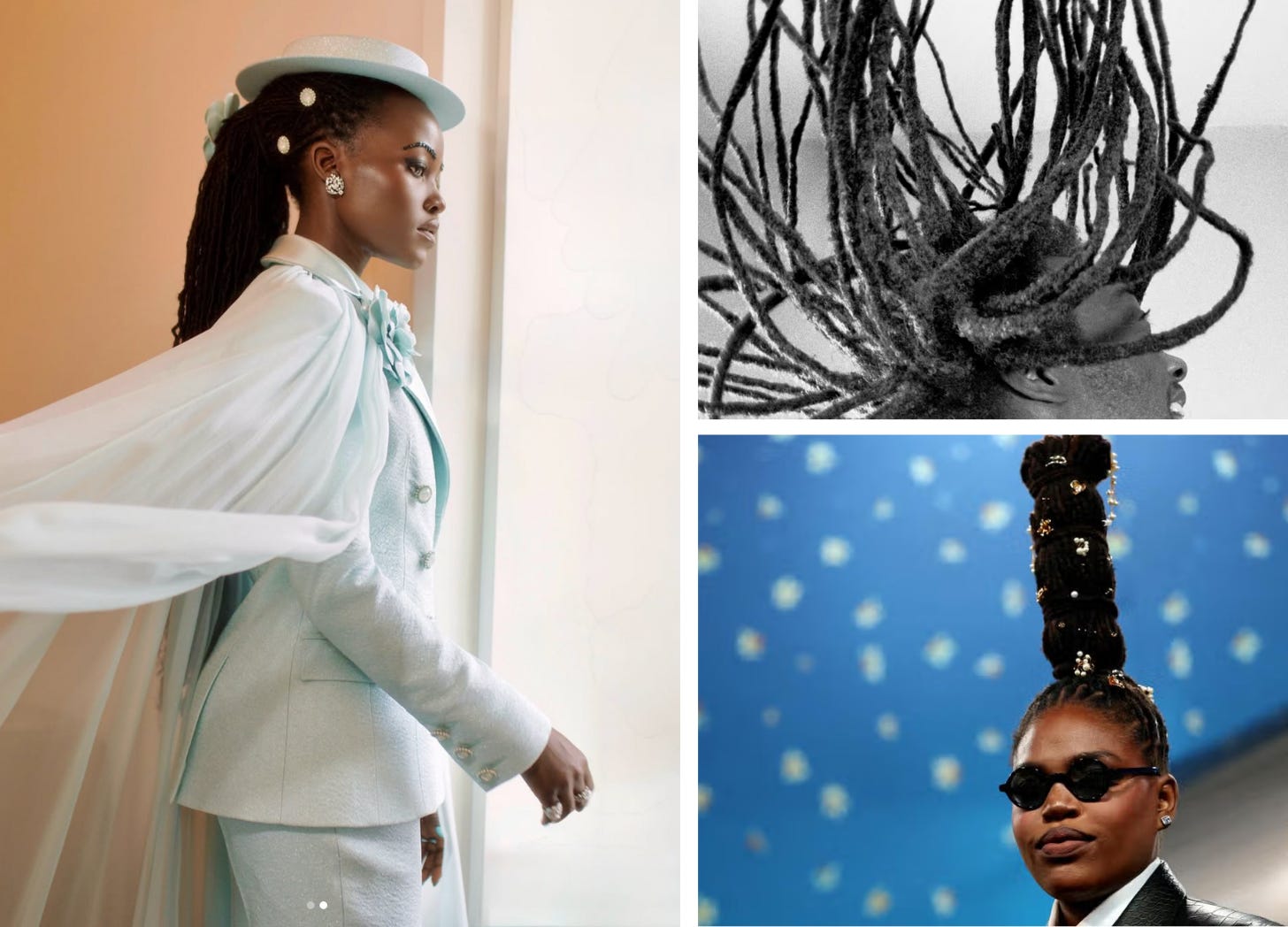
Long before they were red carpet-ready, locs carried weight — spiritually, culturally, politically. Alongside the afro, locs remain one of the most distinctive Black hairstyles across all ethnic groups. And while most mainstream references stop at Bob Marley, the truth is they trace back much further: ancient Egypt, Ethiopian warriors, Hindu sadhus, and beyond.
In the 1920s, Marcus Garvey sparked a Black nationalist movement that later inspired the birth of Rastafarianism in 1930s Jamaica. Within that movement, locs weren’t just a style, they were a spiritual declaration. For Rastafarians, letting hair grow freely symbolizes a devotion to nature and sacred living. The term “dreadlocks” itself, first used in the 1950s, was initially derogatory — marking the marginalized. But like much of Black culture, what was once ridiculed became revolutionary. Over time, locs have evolved into a symbol of resistance, individuality, and power, refusing conformity and rewriting beauty standards on our own terms.
Styled by Vernon François, Lupita Nyong’o’s elongated loc ponytail echoed the elegance of her powder blue Chanel suit while staying grounded in Black identity. The 40-inch Sisterlocks, handcrafted in Nairobi by Julio Sky, were transformed into custom clip-ins and finished with raw, untouched ends — a powerful nod to natural hair in its freest form. Every detail was layered with care, from the double-clip system for comfort to the hat adorned with hand-sewn buttons. François described the process as one rooted in “intention, care, and cultural pride.” And it showed.
Jonquel Q. Jones delivered one of the boldest hair moments of the night with her towering loc sculpture — an architectural updo styled by legendary hairstylist Kim Kimble in collaboration with stylist Courtney Mays. Adorned with beads, pearls, and gold accents, the look was regal, unapologetic, and rooted in cultural pride. It didn’t just complement her tailored leather suit—it crowned it.
From towering locs to soft afros, intricate braids to sculptural waves, the 2025 Met Gala carpet was a celebration of natural Black hair in all its glory. Each look reminded us that hair is style and a language. It speaks of lineage, legacy, resistance, and joy. And this year, it was the main event. Black celebrities showed up not only tailored in fabric, but in identity, crowning themselves in curls, coils, and culture that couldn't be ignored. What a homecoming.
connect with us: instagram → pinterest → twitter → bluesky






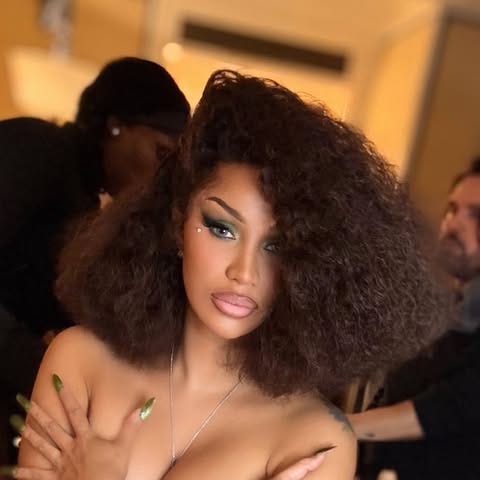
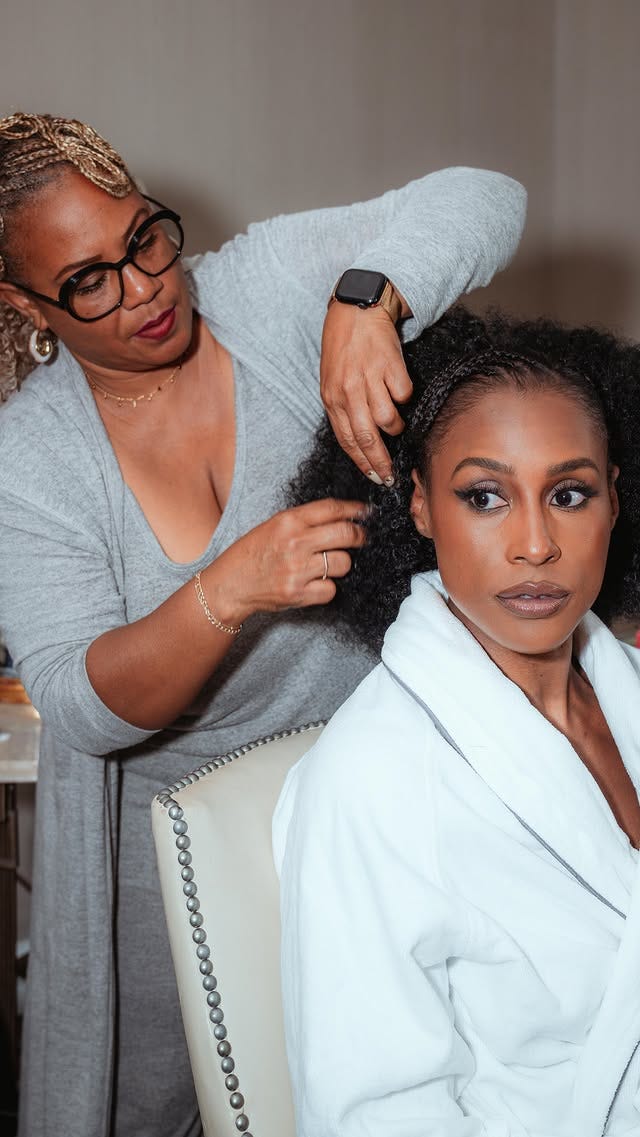

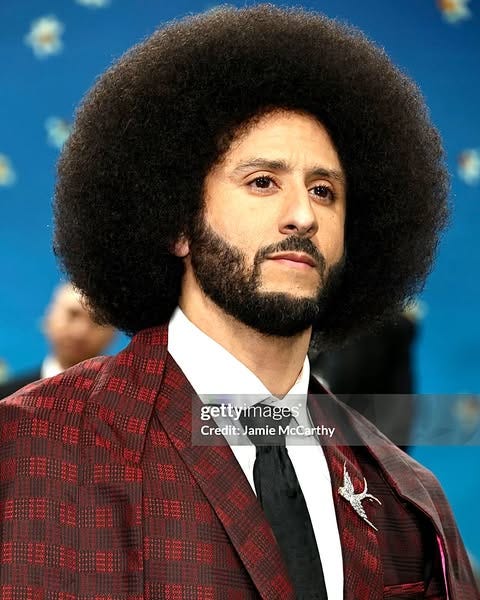


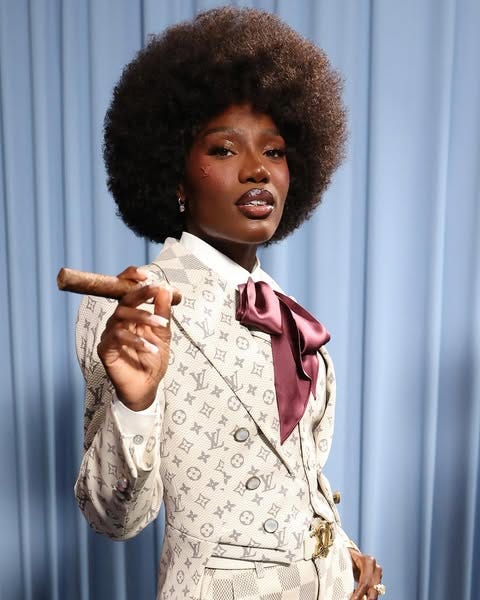



This was a good one. Love sharing history and how it ties in with modern art.